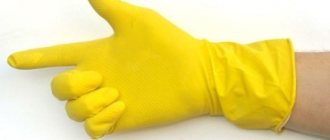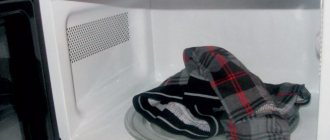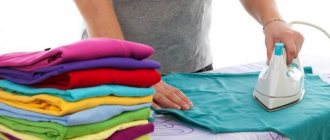The appearance, condition and service life of clothing depend not only on proper washing, but also on proper drying.
A frivolous approach leads to deformation of products - stretching in width or length, yellowing, wrinkles, thinning and fragility of the fabric.
When choosing a drying method, you need to take into account the type of product and the composition of the material. It is equally important to pay attention to the general rules and recommendations that will help dry clothes quickly and efficiently.
Let's take a closer look at how to quickly and properly dry clothes after washing at home.
Precautionary measures
You should not thoughtlessly dry the product using the first, seemingly reasonable method you come across. This can ruin an item or household appliance. Here are a few tips to consider before you start drying:
- Under no circumstances should you dry things over a stove or other open fire sources. Firstly, some products may shrink. Secondly, the fabric is flammable; a very small thread can lead to a fire. At best, the clothes will be damaged, at worst, a fire will start.
- Do not dry clothes on electrical heating appliances, such as a heater. You can get an electric shock and cause a short circuit, which will ruin both your clothes and equipment.
- Also, do not neglect the instructions that are on the label. Thanks to them, you can find out what type of washing and drying is suitable for the fabric. For example, wool, silk and lace cannot be dried directly with an iron; they should only be ironed through gauze.
- A common mistake is to dry shoes on a radiator. However, this is strictly forbidden. Because of this method, the sole becomes deformed and quickly becomes unusable. You need to wash shoes and sneakers in a special bag.
- You should not resort to emergency drying too often, as this is a lot of stress for the fabric. The item can quickly wear out and become unusable.
How to prepare clothes for drying
After you have read the recommendations on the label, wash the clothes and turn them inside out. Then dry in a manner suitable for this type of fabric. Natural methods: in the sun, frost and wind.
In the sun, under the influence of ultraviolet rays, laundry dries very well, as moisture evaporates faster.
In cold weather, at sub-zero temperatures, laundry dries as quickly as in the sun and acquires frosty freshness. Clothes are covered with frost, consisting of crystals, which quickly evaporate in the cold if there is high humidity outside.
Proper organization of space for drying clothes
The general rule: the drying area should be well ventilated, without high humidity and foreign odors. The kitchen and bathroom are not the best options for drying clothes, if you have a choice.
Small room
For a small room without a balcony, a floor-mounted vertical dryer is suitable. It does not take up much space, can be folded in half, and after drying it is folded and put away for storage.
A vertical dryer is suitable for a small room
It is important to organize ventilation of the room during drying by opening windows or vents. For small items, it is convenient to have an additional compact dryer with a radiator attachment, or you can hang it on the door
A removable dryer with a radiator attachment saves useful space and speeds up the drying of small items
Studio apartment
In such a room there are more possibilities for organizing drying; the ideal option is a drying machine or washing machine with a drying function. They can be placed in the bathroom, kitchen or hallway, if space allows.
A dryer or washing machine with a drying function is the best option for a small apartment
A simpler and more budget-friendly option is a liana dryer over the bathtub. The downside of this option is the increased humidity in the bathroom and the inability to take a shower at the same time as drying clothes. With this arrangement, it is advisable to have good exhaust ventilation; keep the door ajar during drying.
The Liana dryer can be placed in the bathroom or on the balcony
An electric or water heated towel rail will help to cope with the problem; small things will quickly dry on it: children's clothes, socks, T-shirts.
A heated towel rail will help dry baby clothes and other small items
For kitchen towels, it is convenient to have a small pull-out drying rack in the kitchen, built into a table or cabinet.
A retractable drying rack built into the kitchen cabinet is convenient to have for drying towels
Suitable for a one-room apartment and dryer options for a small room.
Apartment with a loggia
A loggia or even a small glazed balcony in an apartment will greatly facilitate the process of drying clothes. A ceiling or wall-mounted dryer installed under the ceiling will not interfere, will not take up much space and can accommodate a large volume of laundry.
The loggia dryer can be wall-mounted
The advantage of drying clothes on the balcony is the ability to organize good ventilation, which will speed up the drying of the clothes.
House, dacha, cottage
In a private home the possibilities are even wider. In summer there is no better place than fresh air. String ropes outside or set up a portable umbrella dryer.
For drying outside the city, you can pull ropes
To protect from rain, it is better to organize drying under a canopy or on the terrace. In this case, it is convenient to install a ceiling option.
The umbrella dryer does not take up much space and is convenient to use.
They can also be used in winter, then your laundry will smell frosty fresh without any conditioners. True, after drying in the cold, the laundry will have to be dried indoors.
If possible, organize a separate room for washing and drying, this will relieve you of complexes about laundry exposed to public display. Such a room must have good ventilation.
A boiler room, attic, or bathhouse can also be adapted for drying clothes. The main thing is that the room is dry, clean and well ventilated.
Express methods will help out in emergency cases when there is no time to properly dry the laundry. Do not forget that their frequent use will damage things. Still, the best way to dry is in natural conditions with good air circulation. Consider a place and method for regular drying so that your laundry is fresh and lasts a long time.
Rules for different types of things
Each type of clothing has individual drying rules.
Bed linen
The place for drying bed linen can be chosen depending on the season and personal preferences . In the summer, for these purposes you can use the area near the house (if the house is private) or the balcony (if it is an apartment building). You can also dry it indoors, but it must have good ventilation.
There are several ways to make the drying process easier:
- The dryer is a compact device that can be installed in the bathroom or kitchen.
- Washing machine with drying function.
- Floor dryer . Compact and stable, it can be temporarily placed in any room of the apartment, and after drying, put away in the dressing room or corridor.
- Ceiling dryer with mechanical control or remote control. This functional device can become a harmonious addition to the interior of a bathroom or balcony.
- "Intelligent" dryer . Can be either wall or ceiling. Controlled remotely via remote control. Its functions include folding and unfolding, adjusting a comfortable height, as well as blowing warm air over the laundry for faster drying. The downside of this ergonomic design is the high price.
When drying bed linen, you need to follow the recommendations that will extend its service life:
- keep silk products away from heating devices;
- cotton should not be dried until completely dry to make ironing easier;
- Linen in dark and colored colors should not be dried in direct sunlight.
Underwear
You can only dry your underwear outside if you live outside the city, where there is always clean, fresh air. In a metropolis with an abundance of exhaust gases, it is best to dry these delicate clothes in contact with the surface of the body in an apartment.
There are several rules:
- The room in which underwear is dried should be well ventilated and protected from direct sunlight.
- Silk and viscose items should be dried away from heat sources.
- Cotton linen can be hung on a line after being shaken and straightened.
- It is recommended to dry silk and synthetic items laid out on a thick terry towel.
- It is recommended to dry bras on a horizontal surface. First you need to straighten the cups so that they maintain the correct shape.
Using household appliances
Every home has devices that are sources of heat. Thanks to them you can quickly dry wet things.
Washing machine
Even if the machine does not have a special drying mode, spinning can do most of the work.
In order to dry the desired item after washing and not spoil it, you should follow a certain algorithm:
- Place the product in a white pillowcase. It should not be very large so that clothes do not dangle in it.
- Tie the pillowcase tightly or sew it up for security.
- Place in the washing machine and spin for 15 minutes.
If during the spinning process the pillowcase accidentally comes undone, you need to turn off the machine, otherwise the item may be deformed under the action of the centrifuge.
Heaters
This option is suitable for drying in winter when the central heating is on. First cover the battery with a clean sheet so that rust does not accidentally get on your clothes. Lay out the wet item. Drying usually takes more than 40 minutes. You can dry gloves, socks, and hats on the radiator. Larger items may become deformed due to the unevenness of the battery.
Using a fan-type heater is effective. The circulation of warm air dries clothes faster.
Warning! When choosing this method of drying things, you must remember safety precautions. Do not set the temperature too high and do not hang wet things directly on the device, so as not to cause a fire.
Hairdryer
Large items such as a sweater or jacket cannot be dried quickly with a hairdryer. But this device effectively copes with wet underwear, socks, and nylon tights. You need to proceed in the same way as when drying your hair. Direct a stream of hot air at the items until they are dry. Keep the hair dryer at a distance of 50 cm from the product. Blow them from different sides to ensure even drying.
Iron
Its use must be very careful. At high temperatures and insufficient humidity, the product can simply be ruined, especially if it is made of delicate fabric. You can use an iron to dry cotton, linen clothes and bed linen.
Turn the item inside out, lay it on the ironing board and iron it. Hang on a hanger and let it cool for 10 minutes. Then iron from the front side. Let cool again on a hanger. Repeat the procedure if the product is still damp.
Microwave
You can dry small items in it (socks, underwear, shoelaces). First you need to make sure that there are no metal parts on them. Turn on the microwave oven for 30 seconds at medium power. If the item is not dry, repeat the procedure. You must not leave the device for a second while it is working, so that you can turn it off if something does not go according to plan.
If you don't have time to wait
There are five easy ways to dry clothes that you urgently need to wear but are still wet. To do this you will need something to choose from:
- iron,
- oven,
- microwave,
- electric dryer,
- hairdryer or fan.
Iron dry
There is an iron in almost every home. Therefore, it is easiest to use it. When wet fabric comes into contact with the hot surface of the iron, the moisture evaporates and the clothes become dry.
Place the damp item on a table or ironing board and iron with a hot iron until the material is dry.
Be careful and choose the temperature setting for individual types of fabric. It is good to iron cotton and linen items at maximum temperature, while for synthetic and silk fabrics it is better to choose a medium setting.
However, such drying is not suitable for woolen and knitted items: the fabric may become deformed (stretch, shrink) or even stick to the sole of the iron.
Video: how to dry a washed shirt in 10 minutes
Dry near the oven
A non-standard drying option is to use a conventional oven. But before that, it is important to wash it from the inside to avoid foreign odors on the clothes. The sequence of this drying is:
- Turn on the oven.
- While it is warming up, prepare your things by hanging them on the back of a chair.
- When the oven is hot enough, open the door and place a chair with clothes as close to it as possible.
- Turn things over periodically to dry them evenly.
You can use a more daring option: hang things directly on the oven door itself, also turning them over periodically. The main thing is not to leave clothes unattended so as not to ruin them. But still, few people decide to hang washed clothes on the oven door, because in this way it is easier to get them dirty than to dry them.
Microwave oven as a helper
A microwave is good for more than just heating food. It can also handle drying clothes - from thin socks to thick T-shirts. Users online say that this method is completely ineffective: things just heat up, and that’s it. Yes, heating occurs inside the microwave for some time. But the longer the item warms up, the faster the moisture evaporates from the fabric. After all, everyone knows that, for example, a puddle of water on the road will disappear faster in hot weather than in simply warm weather. So feel free to experiment. Just avoid things with metal parts so as not to damage your equipment.
So what is the correct way to dry clothes in the microwave? Let's figure it out:
- Take any item that needs drying. For example, a T-shirt.
- Carefully fold the item so that it fits on the microwave tray. Put it there, close the door.
- Set the power to maximum or average.
- Set the timer for 30 seconds.
- Then check the T-shirt - if nothing bad has happened to the material, then feel free to continue warming the clothes, periodically checking them for dryness.
Using an electric dryer
An electric dryer is a convenient device that quickly dries clothes. Now there are many different designs on the market - from floor-standing “clamshells” to round and rectangular “cabinets” with covers.
All of them are easy to use: you need to hang the laundry on the rods, set the temperature and drying time. This allows you to use the device for all types of fabric, since it is possible to regulate the temperature.
Hair dryer and fan
What do most girls do when their hair is still wet and there is little time left before going out? Take a hairdryer. So why not use it to dry things? When exposed to hot air, the fabric gets rid of moisture, so this option is as effective as an iron. To do this, take the clothes and, hanging them on hangers, dry the entire surface with a hairdryer. Drying time depends on the fabric: the denser it is, the longer it will take for the moisture to evaporate.
A floor heat fan will also help dry your clothes.
Here the principle is the same: a flow of heated air evaporates water from the fabric. Hang your clothes and put a fan near them. Keep it on until the item is dry.
Using the oven
This drying method will take a little longer than the previous ones. Drying will take about an hour, sometimes more. You should proceed as follows:
- Hang the wet item on a hanger on the back of the chair.
- Preheat the oven and open the door.
- Place a chair next to the oven.
- Leave everything like this for an hour.
- Periodically, you need to turn your clothes over so that they dry evenly.
Important!
Be very careful, because the item may catch fire. Some people hang their clothes directly on the oven door. If you hang something very close to the oven or the door itself, it will absorb all the odors from the oven. And then you will smell not of pleasant perfume, but of baked chicken. It's unlikely that anyone will like it.
Which option is the fastest, how to speed up the process?
The fastest and most reliable way to dry clothes is to use a special drying machine.
However, in its absence, you can use other recommendations to speed up the process:
- A heat fan that will increase the circulation of heated air indoors. This method is also effective for drying wet clothes after a walk.
- Wool items that cannot be ironed due to the risk of damaging the fibers can be dried with a hairdryer. Set the medium mode and treat the product evenly with warm air for half an hour.
- Products that are not susceptible to heat can be heated with an iron. Set the temperature to medium, turn off steaming and carefully iron the item, turned inside out, over the entire area. Hang on hangers, and after half an hour repeat the procedure.
- In case of emergency, you can use the oven. Preheat it to 200 degrees and open the door. Place a chair nearby with clothes that urgently need to be dried. To ensure uniform penetration of hot air, the item must be turned over. The oven must be thoroughly cleaned to prevent food odors from permeating the clothes.
Using a microwave oven
This method of drying clothes quickly is only suitable for small items such as socks, shoelaces, gloves or underwear. The rules of use are very simple:
- Place wet clothes on the bottom of the microwave.
- Turn on medium power and heat the products for about 30 seconds.
- Repeat these steps until completely dry.
Important!
At first glance, this method is very simple and safe, but there are some cautions that you must follow:
- Before placing in the microwave, make sure it is clean and free of grease. Otherwise, socks or gloves will have to be washed again.
- Do not leave the oven unattended while drying.
- Microwave drying time per cycle should not exceed 30 seconds. Therefore, you cannot turn on the device for 10 minutes and wait until the socks are completely dry. Most likely, the material will begin to smolder.
- Make sure that the items you are drying do not have metal elements.
How to dry things
4. Hang at full length.
If you've washed a lot of shirts, dresses and pants, it's best to hang them on a hanger to dry. There are 2 reasons for this:
*They will dry faster than on a drying rack or clothesline.
* Wrinkles will be smoothed out, things will be more convenient to iron, and you will save a lot of time.
Despite the routine nature of manipulating washed items, we persistently make the same mistakes, complicating the task of subsequent care. How to properly hang and fold washed clothes?
It would seem, what kind of wisdom can there be when we do all this - wash, dry, hang, fold - almost every day! And yet, day after day, we slowly spoil our clothes or make it difficult to care for them ourselves. So what do we often do wrong?
Learning to fold
But it so happened that we did everything right, the laundry dried perfectly, and then we put it in the closet, pulled it out, and it was wrinkled... Grab the iron? No! Learn to fold things correctly!
- Long dresses, floor-length skirts, suits should be hung on hangers and arranged in strict order.
- Try to carefully place all wrinkled items on hangers!
- It’s easier to roll up sweaters, T-shirts, bed linen, and towels and neatly place them on the closet shelves.
And the last tip for today: have a steamer for emergencies. They are small in size and quickly help remove treacherous wrinkles on the fabric.
Celebrities who choose budget brands
Give a man a wallet around his neck - this is a new trend
How to dry it properly at home?
Valuable recommendations will help dry clothes faster, while maintaining their neat appearance and freshness:
- After washing, you need to shake each item - this will remove excess moisture and give the material the correct texture.
- Hang shirts and trousers that have been washed in large quantities on full-length hangers and place them on a line.
- Radiators and heating devices should not be used for drying, although they speed up the process. Under the influence of strong direct heat, the structure of the fabric threads weakens and the clothing becomes deformed.
- Do not leave washed items in the washing machine for more than an hour. This leads to an unpleasant musty odor that is difficult to get rid of.
Rules for drying clothes vary depending on the chosen location.
On air
Before drying laundry or clothes in the fresh air - on the street or balcony - you need to clean the ropes from dust, dirt and traces of rust.
In sunny, hot weather, it is necessary to turn the products inside out before hanging to maintain color saturation.
Drying on frosty winter days gives the laundry an extraordinary natural freshness. But there is also a risk of the fabric freezing, as a result of which it will become fragile and brittle.
To prevent this failure, you need to dissolve a little table salt in water when rinsing. It is also recommended to wipe the drying ropes or bars with a soft cloth soaked in a salt solution.
In room
A small number of clothing items can be dried indoors at room temperature.
This method is applicable for the cold season. Its advantages are faster drying of things and humidification of the air. It is not advisable to hang washed laundry in the kitchen, where it can become saturated with all sorts of odors from cooking. The exception would be hanging things up at night, when there are no culinary processes. To ensure proper air circulation, you need to hang your laundry in the correct order when using a drying rack. Small things should be placed at the bottom, and large ones at the top.
The room in which clothes are dried must be constantly ventilated. To make the most of your drying rack space, you should use clothing hangers.
In older homes, as well as in rooms where condensation accumulates on windows, the presence of a clothes dryer can aggravate the problem. In such situations, it is advisable to purchase a dehumidifier.
During the day, the linen rack can be moved around the apartment. Thus, it will receive a large amount of natural sunlight.
In the dryer/machine
If you use a washing machine or dryer for drying, the timer can be set for no more than 30 minutes.
This method, due to deformation, is absolutely not suitable for drying the following types of things:
- ultra-fine fabrics;
- knitwear and lycra products;
- down jackets;
- wool clothes;
- products decorated with sequins or rhinestones;
- things with fillers.
Where to dry clothes in an apartment
The best place to dry clothes is in fresh air. If you live in an apartment, properly equip the balcony with tight ropes, or, if space allows, install a horizontal dryer.
But what to do if there is no balcony? In this case, you have to look for a suitable place in the apartment. Many people pull ropes in the bathroom, but this only prolongs the drying time of the laundry, since the humidity in the room is high.
You should also not dry things in the kitchen. Although this room is the warmest in the apartment, there is no place for wet clothes. By hanging laundry in close proximity to food, you risk ending up with a dry item that is heavily “decorated” with stains.
It is not advisable to dry clothes in the kitchen due to their proximity to food and odors.
The best option for drying wet laundry in an apartment is a room located on the sunny side and well ventilated. In this case, the clothes will quickly become dry, and excess dampness will not appear in the room.
How to quickly dry things after washing at home
Items with minimal moisture become dry faster, so it is important to wring them well. To remove water, you can turn on a special program on your washing machine.
But here it is important to remember that you do not need to set the maximum number of revolutions so that things do not get too wrinkled. It is also important to recall the existence of fabrics that only require natural drying.
Machine dry
What progress has come! Now you can buy a special drying machine, with which you can conveniently and quickly dry all your washed items. Thanks to the high temperature, this procedure will only take half an hour. But this method also has disadvantages:
- Equipment needs additional space to be placed.
- The machine is not a cheap pleasure.
- Not suitable for all fabrics. So, you cannot dry knitted, woolen, down, feather products in it, as well as those made of lycra, thin fabric and those with rhinestones and sequins. Such things can become deformed.
Not everyone can buy a dryer, but a washing machine with an automatic drying mode is quite possible. Many modern machines are equipped with a two-in-one function, which saves space, time and money. However, this option also has certain disadvantages: the cost of the machine is beyond the budget, and electricity consumption increases significantly with frequent use
It is also worth paying attention to the opinion of some experts that the constant use of electric dryers reduces the service life of laundry
Electric hand dryer
Today, electric hand dryers are becoming increasingly popular in everyday life. The device is also called a hand dryer, an electric towel and is placed in the bathroom. The dryer allows you to dry your hands quickly and inexpensively, as it consumes a minimum of electricity. The device is absolutely safe and is protected from short circuits even during voltage surges. With its help, you can really quickly dry clothes after washing. There are models with manual and automatic activation, highly functional devices of compact sizes. Having such a device, you can immediately “kill two birds with one stone”: refuse paper and fabric hand towels and dry your laundry if necessary.
Cupboard drying
The drying cabinet is a modern design, equipped with a heating element and electrical automation. Inside there are telescopic hangers, shelves and hooks, which eliminates the need for ironing. After washing, things are placed in a closet, where they are blown with warm air, which quickly removes moisture without deforming the fabrics. Universal household drying cabinets are made with four independent internal sections, which guarantees complete hygiene during the drying process. A standard closet can accommodate three or more washes. Most often, the device is installed in the corridor, hall, bathroom or dressing room. It is not recommended to install a drying cabinet in living rooms, since its operation is accompanied by a certain noise.
Using an iron
An iron will allow you to quickly dry clothes after washing at home. The device allows you to finish drying items that have been previously wrung out in the washing machine, when the main moisture is no longer present. The product is ironed on both sides, then hung out for a short time and ironed again.
If the laundry was washed by hand, use a towel first. The wrung out item is laid out on a terry towel and rolled into a tight roller. The roller is rolled on the table several times, applying force. When the towel is saturated with moisture, it is replaced with a dry one and manipulations continue. Next, the product is laid out on a towel and ironed, turning off the steam supply. After the item has hung a little, it is ironed again without a towel. This way you can dry linen and cotton items, as well as jeans.
Drying wet clothes on a radiator
A central heating radiator is not the best solution for drying things out, but it is quick and effective in winter. Drying clothes on a radiator is justified only when other methods are impossible. After all, drops of condensation accumulate in the corners of the room, which leads to the formation of mold. In case of frequent need, it is worth using a dryer with a battery mount. This option does not spoil things and is safe for health.
Precautions when drying with electrical appliances
In addition to electric drying, you can quickly dry clothes using a heating radiator. A regular battery is suitable if you need to dry wet trousers or a shirt faster, but this method can only be used during the heating season. The rest of the time, oil and other types of radiators come to the rescue. To take advantage of all the benefits of the method and not spoil your favorite item, you should follow simple rules.
How to quickly and easily dry clothes using electrical appliances:
- Items should be wrung out as much as possible in the washing machine, by hand, or the remaining moisture must be removed with a terry towel.
- Small items of clothing - socks, swimming trunks - can be laid out on an electric radiator, and large items - shirts, trousers, jackets - can be dried near a heating device.
- It is better to hang things on the radiator itself in only one row.
Electric models of modern heating devices are safe, have the ability to adjust the temperature and help speed up drying by several hours.
How to choose the right place for drying in an apartment
Hanging laundry all over the apartment is annoying for many people. You can get rid of this by using a drying device. Only in this case may problems arise with choosing the optimal location. You can place the unit next to the washing machine; if space does not allow, place it on the second tier.
If the bathroom is small, you need to look for a place in the hallway or in the kitchen.
There are many folding models of dryers that allow you to place them unfolded in any room, on a loggia. There is a built-in type design in the closet that can accommodate a lot of things. If necessary, simply pull out the system.
Another suitable option would be a dryer that attaches to the radiator. This design allows you to dry your laundry in a couple of hours during the heating season.
Thanks to the drying speed, space is quickly freed up for the next batch.
In the corridor at the top of the wall you can attach a folding accordion dryer.
Under the ceiling in any room. If necessary, you can lower it, loading it with things.
There are mechanical systems, as well as more advanced ones with a control panel, a blowing option, and turn off and turn on automatically. Especially relevant for drying things in an apartment where there is no balcony.
In small apartments where there is no loggia, special multi-complexes are purchased that purify the air, fight fungus, and absorb moisture.
Hanging bookcase
- Two wooden boards - 3 cm thick, 30 cm wide and 1 m 20 cm long,
- 4 screws, 5 mm in diameter, 4 cm long with a ring, which are screwed into the boards,
- 4 screws, diameter 6 mm, length 10 cm, for screwing into the ceiling,
- 4 pieces of metal cable, each 40 cm long, with a cross-section of 2 - 3 mm and four clamps,
- four metal L - staples, for fastening boards together and wood screws, size 6 - 10 cm
Step number 1
Let's prepare the boards. Sand with sandpaper and paint with wood paint.
Step number 2
After the paint has completely dried, screw small 4 cm screws along the edges of one board. To do this, retreat 20 cm from the ends and 5 cm from the edges. To screw in the screws, you must first drill holes to a depth of 1.5 - 2 cm in the board using a drill with a diameter of 5 mm.
Now let's connect both boards using L-shaped brackets, and additionally screw in 5 - 6 wood screws.
Step number 3
It is necessary to drill four holes in the ceiling. To do this, take the measurements between the screws screwed in in step two. In our case, we got a rectangle with dimensions of 20 cm * 80 cm. We transfer the resulting size to the ceiling, drill holes in the corners of the rectangle with a drill with a diameter of 6 mm, then insert plastic dowels and screw in 4 6mm screws.
Step number 4
We prepare the cables. Using clamps, make a loop at one end. We thread the other end through the fastening ring in the shelf and also clamp the loop.
Step number 5
Now we’ll hang our shelf and, using a building level, check the structure for compliance with the horizontal.
OK it's all over Now. We made the shelf with our own hands, all that remains is to enjoy the result of the work done and choose a decorative option.
The best posts
- How to add zest to the interior with pistachio-colored curtains
- Decorating the balcony with decorative stone: imitation of expensive masonry
- Technology for gluing non-woven wallpaper: step-by-step instructions
- How to make a glass coffee table with your own hands?
- How to choose a program for curtain design
- Drawings on the walls in the apartment: original interior design of the apartment
- DIY textured ceiling
- “It’s forbidden to live luxuriously”: the castle of Pugacheva and Galkin
Related article: Step-by-step installation of an air conditioner with your own hands (17 photos)
Fast drying conditions
Drying clothes means removing moisture from them when several conditions are met. These include good air circulation and exposure to high temperatures.
In order to dry the item efficiently and not damage the product, you need to follow certain recommendations.
First, it is recommended to study the label on the clothing. This will help you choose the optimal drying conditions depending on the type of fabric. A number of factors affect how quickly clothes dry:
- fabric type;
- spin;
- density of hanging things;
- temperature regime;
- air circulation.
The removal of liquid from the laundry begins during the spin cycle. The better the product is pressed, the faster it will dry. To achieve good results, it is worth setting the maximum number of revolutions. When washing by hand, the quality of the spin cycle is affected by the material of the product and the strength of your hands.
Experts do not recommend vigorously squeezing delicate or woolen items. When washing such items, you should allow the excess liquid to drain on its own.
You need to twist clothes carefully - delicate fabrics can be damaged
The type of fabric is important. The more the material absorbs moisture, the longer the product will take to dry.
First of all, this should be attributed to natural materials - wool, linen, cotton. Synthetic fabrics dry much faster because moisture does not enter the fiber structure and evaporates rather quickly.
The speed of drying of things is also affected by the density of the fabric. Thick and dense materials take much longer to dry than thin and light materials. Therefore, drying a jacket is much more difficult than drying a shirt or blouse.
Exposure to the sun or frosty air helps speed up the drying process. At home, this effect can be achieved by turning on the stove or heating devices. However, drying in the fresh air occurs much faster than in a room.
Another important factor is air circulation. Without this condition, moisture will create a steam cloud over the laundry, which prevents the rapid evaporation of the remaining liquid. This is why things dry much faster in a light breeze.
If you need to dry clothes quickly at home, you should open a window or window. It is best to create a draft. An air conditioner, hood or fan will help speed up the drying process.
Video: What is the danger of drying clothes in the house and how to dry things if there is no balcony?
We also recommend reading:
- 50 Uses of Hydrogen Peroxide and More to Fight Mold!
- How to clean an automatic machine yourself?
- How to clean a shower stall from mold and plaque?
- How and with what to wash tulle?
- How to iron shirts?
- How to iron linen and dresses made of different materials?
- Caring for different types of fabrics
How to put shirts in a closet
Storing a shirt on a hanger may cause wrinkles to form on the shirt and will require ironing again. In order to avoid such troubles, there are ways to fold shirts without creases. If you follow these instructions, your items will remain fresh for a long time.
How to fold a long sleeve shirt. Method number one
For the first method, you will need paper or cardboard, approximately the size of a sheet of A4 paper. It will help fold the shirt straight.
- First you need to fasten all the buttons, including the sleeves, as well as the collar. Smooth out so that there are no wrinkles or wrinkles.
- Then we place the shirt front down.
- Then we lay a sheet of paper or cardboard so that the edge of the sheet touches the collar.
- We bend one side from the shoulder to the center around the sheet.
- The next step is to lay the sleeve like an accordion on the resulting half of the workpiece.
- Now we do the same with the second half of the shirt.
- After all this, all that remains is to fold the shirt in half from the bottom to the collar and put it on the shelf for storage.
The cardboard can be removed or left inside.
How to fold a long sleeve shirt. Method number two
- The first step is to fasten all the buttons and place the shirt with the clasps down.
- First you need to take one hand between the shoulder seam and the collar. At the same distance from the edge, but from below, we take the shirt with the other hand. If you pull it, the line will be noticeable.
- Along the resulting line, bend the edge of the shirt towards the center.
- In this case, carefully place the sleeve on top of the folded part.
- Next you need to repeat the procedure with the other half.
- Then, the resulting workpiece needs to be folded in half from bottom to top. If necessary, the shirt can be folded not in half, but in three.
By the way, the methods described above are also suitable for short-sleeved shirts. You'll just have to do less manipulation with the sleeves when you lay them out.
How to properly display goods in a clothing store?
Items must be folded so that inscriptions or logos are not on the fold and are visible. Shirt buttons or zippers must be fastened. All magnets on clothes are attached to the right side of the seam so that there are no holes left when removed. It is prohibited to post contaminated or defective goods.
Interesting materials:
How to view your subscriptions on VK? How to view your profile on Avito? How to watch a video on YouTube with limited access? How to view all materials of a VK conversation? How to view all your subscriptions on iPhone? How to see all your RGs in Minecraft? How to view bookmarks in your Google account? How to view bookmarks in Opera GX? How to salt frozen herring? How to install a block on a Samsung TV?
How to quickly dry pants after washing
To dry pants made from thick fabrics, such as jeans, you can use the following method:
- Wrap the wet item in a terry towel so that it is completely hidden in the “cocoon”.
- Gently “unscrew” the package several times, as if squeezing by hand. You shouldn't apply too much force - you risk tearing the towel. If you don’t want to wring out the fabric, you can simply sit on a bundle of clothes; the weight of your body will absorb the moisture into the material.
- Remove the terry cloth from the item and shake it several times to remove any wrinkles. If the pants are still too wet, repeat the procedure.
Related article: How to sew a one-shoulder summer dress with your own hands: pattern and sewing master class
To speed up the process, you can dry your clothes with a hairdryer or iron.
How to hang a T-shirt?
Folding T-shirts
- Place the shirt face up on a flat surface.
- Fold the sleeves of the product inward at the point located in the middle of the shoulder seam.
- Next, the T-shirt
should be folded in half (along the horizontal axis). You can make either one or two bends - it all depends on the free space in the closet.
Interesting materials:
Why is the Cockerel Fish sick? Why did the cockerel fish swell? Why did the fish change color? Why does a fish in an aquarium swim on its side? Why is Pisces the best zodiac sign? Why are fish fickle? Why does lemon make tea lighter? Why does a hangover cause weakness? Why does the battery die in cold weather? Why did the Avito website become paid?
Features of drying various items of clothing
Wardrobe items are made from delicate and thick fabrics and dry at different times.
Pants and trousers
Clothing made of durable material takes a long time to dry. A hairdryer helps speed up the process. First, hot air is directed to one side, seams and pockets are dried, and the belt is not forgotten. The trousers are ironed through gauze or cotton fabric using a high heating setting. Pants dry quickly:
- in the sun or draft;
- near the oven;
- in an electric dryer.
20 ways to quickly get rid of linen lice at home
You need to turn your trousers inside out and make sure they are dry on all sides. After heat treatment, it is not recommended to put on pants immediately.
Socks
Any wet item of clothing makes a person feel uncomfortable, and in addition, you can get sick. Fungus often appears on the feet from wet socks. They dry quickly:
- when heated by a hairdryer or fan;
- when ironing;
- when placed on a radiator.
Small items are dried in a terry towel in the microwave. Even on a battery, the drying process does not take more than an hour.
Sweater
After washing, hang a sweater, jumper or other long-sleeve item in the fresh air; the sun and wind contribute to the evaporation of moisture. The jacket dries out when rolled up in a terry towel. To speed up the process, turn on the electric dryer, use a hair dryer and iron.
T-shirts and tank tops
After washing, items made from cotton or linen are spun manually or in a machine, setting the rpm mode to 800. For synthetic items, the maximum spin level is set. T-shirts and T-shirts dry very quickly in an electric dryer; they dry in 20 minutes when using a hairdryer; in a quarter of an hour when ironing.
Lingerie
Sheets and pillowcases are hung on a rope, and the moisture evaporates in the sun and wind. It is better to squeeze the panties well in the washing machine, place them on an electric dryer, and if there is none, near a fan. When the linen is dry, iron it.
Shirt
Clothes made of cotton or linen are folded into a terry towel and carefully wrung out, turned inside out, hung on hangers, slightly heated with an iron. A shirt made of silk, poplin, crepe de Chine is dried with a hairdryer
Jeans
To prevent trousers made of thick material from losing color or shrinking in size, after washing the items are laid out vertically. Jeans should not be hung on a radiator or placed in the sun. Slightly dry items are ironed with the steam function turned off. If the material is wet, blow hot air from a fan onto the trousers. Denim shorts dry quickly when using a hair dryer.
Shoes
The soles of shoes and boots get wet during snow melting and prolonged rains and gradually become unstuck and deformed. To make leather boots last longer:
- Wet shoes are removed immediately.
- Remove the insoles and laces.
- Things are placed in an electric dryer.
Shoes and boots dry out if you blow the items with a hairdryer or fan, fill them with newspaper in several layers, and put a bag of hot salt inside.
Tights
Nylon products are very thin, have a beautiful shine and are inexpensive. This material, like nylon, is used for the production of women's stockings and tights. Such things are dried by placing them on a towel and rolling them into a tube.
Wool sweater
You cannot keep a jumper made of angora or mohair or clothes knitted from woolen threads in the sun or dry them on a radiator, as the product loses its attractive appearance and clumps into clumps. After washing, the sweater is slightly twisted and wrung out to drain the water.
The jumper is placed on a terry sheet or towel, gently wiped, turned over several times or steamed through gauze.
Drying
After getting rid of moisture, it is necessary to properly dry the product. Out of ignorance, housewives again make the common mistake of placing the item in a vertical position on a rope, drying rack or hanger. As a result, this leads to deformation of clothing. You need to dry it on a flat horizontal surface.
The fabric will dry faster if it is hung in a well-ventilated area on a grid surface.
It is recommended to turn the item over periodically while drying.
Several life hacks from resourceful housewives
Many housewives try to dry their clothes so as not to waste time on ironing. I have collected the most interesting and useful finds that will help make life easier.
Let's slow down
It’s interesting, but things wrinkle most of all if they are washed with a spin cycle at high speeds and at maximum load. Accordingly, divide and conquer! It’s better to wash less, but with better quality – reduce the spin speed. By the way, this can extend the life of your favorite dress!
Shake
Before you start hanging, the fabric needs to be straightened. To do this, after washing, take the item and shake it, do it with a quick and strong movement. Clothes dry best when flattened, without folds or creases. Don't skimp on hangers and clothespins!
"Smart" technology
Modern washing machines have drying functions, but don’t get carried away! Excessively dry fabric tends to rigidly store all small and large folds. Sometimes it's easier to wet and dry a shirt like this than to try to steam it!
“No” to manual spinning!
It has long been noticed that when bed linen is wrung out by hand, longitudinal wrinkles form on it, which then dry out. They will have to be steamed or ironed, so we try to do it the easy way, getting rid of water with machines.
Hanging clothes correctly
Each fabric has a set of qualities that are reflected in washing and drying. First of all, we always study the label to determine at what temperature to wash and whether manual labor can be avoided. But it’s also important not to lose sight of the drying method!
- Knitwear and wool should be wrung out in a towel. This delicate method helps preserve the structure of the fiber, prevents your favorite sweater from stretching, and prevents items from being steamed later to remove creases. Then carefully lay the item on a horizontal surface and wait for it to dry. Drying boards or nets can be used for this purpose. If you do everything the other way around, squeeze it in the machine, and then throw it on a rope, then the thing will lose its shape and will have to be ironed.
- To prevent towels from becoming wrinkled, they are hung on a clothesline in a straightened form and the ends are pressed with clothespins. Of course, the result will not be one hundred percent, the surface roughness will remain, and an unironed towel will get dirty faster!
- Shirts are fastened with all buttons during washing; it is better to wash them by hand, paying special attention to cuffs and collars. Then the shirt is hung on hangers or on a rope, clinging to the hem with clothespins. Blouses are dried in the same way. If it suddenly happens that the house has run out of all the hangers and clothespins, then we hang it on a rope at armpit level, where the creases are practically invisible. We do the same with T-shirts.
- We straighten the bed linen to its full length, without folding it in half or in four. It will straighten itself out under its own weight.
- We carefully attach trousers, skirts and jeans to the belt.
To keep kitchen towels and sheets pleasing to the eye for a long time, it is better to tinker with them after washing: dilute starchy water, rinse thoroughly until the fabric is saturated, dry, and then iron. Starch clogs the pores of the fabric, preventing the ubiquitous dirt and dust from penetrating there.











